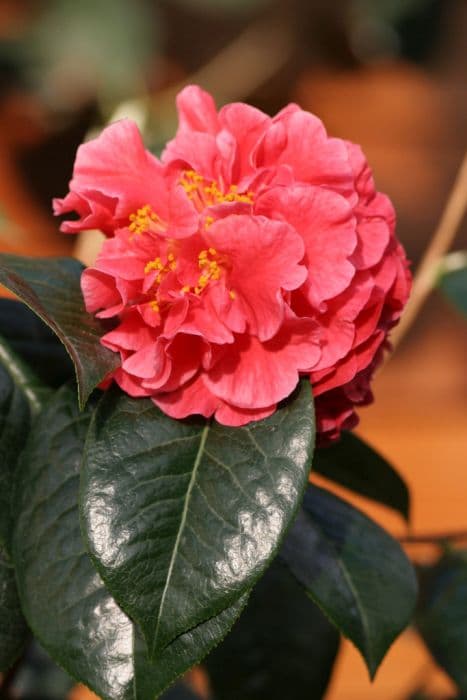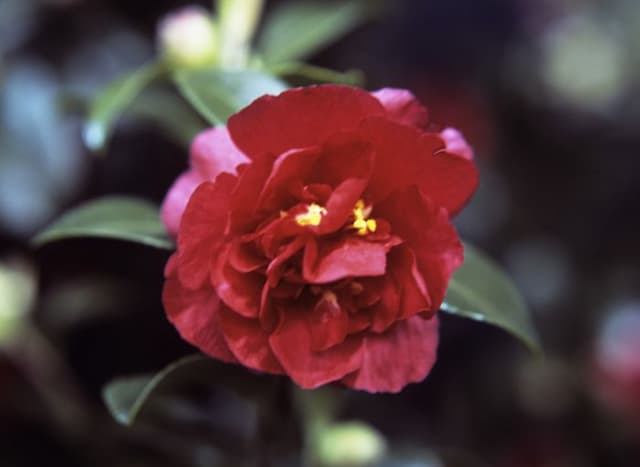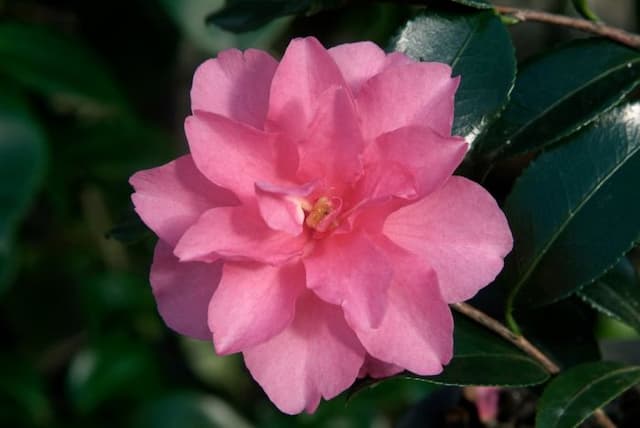Japanese Camellia Camellia japonica 'Margaret Davis Picotee'

ABOUT
The Camellia japonica 'Margaret Davis Picotee' is a captivating flowering plant known for its showy and elegant blossoms. This variety is particularly prized for its distinctively edged flowers. The blooms are large and feature a creamy white base color. What sets the 'Margaret Davis Picotee' apart is the striking pink to red edging along the petals, giving each flower a delicate, painted appearance. The petals themselves are broad and can be either single or double formations, creating a layered look that adds depth and texture to the overall presentation. In addition to the spectacular flowers, this plant boasts glossy, dark green foliage. The leaves are oval-shaped with slightly serrated edges and serve as the perfect backdrop to the contrasting flowers. This provides a lush canvas throughout the year, making the Camellia japonica 'Margaret Davis Picotee' as attractive in foliage as it is when in bloom. As a member of the camellia family, it shares the elegant characteristics of its relatives, bringing year-round interest to gardens with its perpetual greenery and seasonal floral display. The appearance of the 'Margaret Davis Picotee' is one of refined beauty, making it a popular choice for ornamental planting. It lends itself especially well to being a centerpiece in garden compositions due to its striking blossoms and attractive foliage.
About this plant
 Names
NamesFamily
Theaceae
Synonyms
Japanese Camellia, Rose of Winter
Common names
Camellia japonica 'Margaret Davis Picotee'.
 Toxicity
ToxicityTo humans
The Camellia japonica, commonly known as the camellia, is not considered toxic to humans. There are no significant symptoms of poisoning associated with this plant as it is generally regarded as non-poisonous. Therefore, ingesting parts of the camellia is not expected to have harmful consequences for humans.
To pets
The Camellia japonica, commonly known as the camellia, is not considered highly toxic to pets. It is generally regarded as safe, and there are no significant symptoms or consequences of poisoning typically associated with pets ingesting parts of the camellia. However, it is always prudent to prevent pets from consuming plants as individual animals may have different sensitivities, and ingesting large quantities could cause gastrointestinal upset.
 Characteristics
CharacteristicsLife cycle
Perennials
Foliage type
Evergreen
Color of leaves
Dark green
Flower color
Mixed
Height
6-8 feet (1.8-2.4 meters)
Spread
5-7 feet (1.5-2.1 meters)
Plant type
Shrub
Hardiness zones
7-9
Native area
Japan
Benefits
 General Benefits
General Benefits- Ornamental value: The Camellia japonica 'Margaret Davis Picotee' is appreciated for its striking flowers with delicate white petals edged in a rich pink picotee. These blooms add a dramatic and elegant touch to gardens.
- Long blooming season: This camellia typically has a long blooming period which can extend from late fall through early spring, providing color during times when few other plants are in flower.
- Drought resistance: Once established, it is relatively drought-tolerant compared to some other ornamental plants, requiring less frequent watering.
- Shade tolerance: It can grow well in partial shade, making it a versatile plant for different garden situations where direct sunlight is limited.
- Ease of care: Camellia japonica 'Margaret Davis Picotee' is relatively low maintenance, needing only occasional pruning to maintain shape and health.
- Attracts pollinators: While not specifically grown for this purpose, the flowers can attract bees and other pollinators to the garden, which helps in the pollination of other plants.
- Evergreen foliage: It maintains its glossy, dark green leaves throughout the year, providing year-round interest and structure to the garden landscape.
 Medical Properties
Medical PropertiesThis plant is not used for medical purposes.
 Air-purifying Qualities
Air-purifying QualitiesThis plant is not specifically known for air purifying qualities.
 Other Uses
Other Uses- Crafting natural dyes: Camellia japonica petals can be used to create delicate pink and beige dyes for fabrics and textiles.
- Photographic subjects: The striking blooms of 'Margaret Davis Picotee' make it a popular choice for photographers and botanical illustrators.
- Wedding decorations: The flowers can be used in wedding bouquets or as elegant table decoration due to their beauty and formality.
- Educational tool: Camellia japonica can serve as a subject of study for botany students learning about plant morphology and reproduction.
- Aromatherapy: Although not known for a strong scent, its subtle fragrance can be used in creating a calming atmosphere for aromatherapy sessions.
- Cultural symbols: In some cultures, Camellia japonica represents love and adoration, and can be used in ceremonies or gifted to express these feelings.
- Theme gardens: This camellia variety can be an integral part of Japanese-themed gardens due to its origin and popularity in Japanese horticulture.
- Potpourri ingredients: Dried petals of 'Margaret Davis Picotee' camellias can be incorporated into potpourri mixes to add color and mild fragrance.
- Holiday decor: During the winter months, Camellia japonica can be brought indoors as a living decoration, sometimes coinciding with the holiday season.
- Artistic inspiration: The variegated petals can inspire artists and crafters in their work, from watercolor paintings to fabric patterns.
Interesting Facts
 Feng Shui
Feng ShuiThe Camellia is not used in Feng Shui practice.
 Zodiac Sign Compitability
Zodiac Sign CompitabilityThe Camellia is not used in astrology practice.
 Plant Symbolism
Plant Symbolism- Adoration: The Camellia japonica often symbolizes deep admiration and affection, making it a popular gift for loved ones to express heartfelt sentiments.
- Perfection: With its flawless form and symmetrical petals, camellias are associated with perfection and are often used to convey the message that someone is perfect in the eyes of the giver.
- Longevity and Faithfulness: Camellias are known for their long blooming season and hardiness, which translates into symbolism of long-lasting relationships and unwavering faithfulness between partners.
- Divine Love: The beauty of the bloom is sometimes equated with the divine, suggesting an eternal and spiritual form of love when given or displayed.
- Refinement: The exquisite nature of the Camellia japonica 'Margaret Davis Picotee' makes it a symbol of refinement and sophistication in cultural contexts such as the Victorian language of flowers.
 Water
WaterCamellias, including the 'Margaret Davis Picotee', prefer evenly moist soil, so it’s best to water them when the top inch of soil begins to dry out, typically about once a week, depending on climate conditions. During the growing season, this may increase to twice a week. Apply water directly to the base of the plant, avoiding wetting the leaves to prevent fungal diseases. Each watering should provide enough water to soak the soil deeply, which usually amounts to about 1 to 1.5 gallons for an established plant. In winter, reduce watering since the plant's growth slows down and it requires less moisture.
 Light
LightCamellias, including 'Margaret Davis Picotee', thrive in partial shade or filtered sunlight, especially in the morning. They should be sheltered from intense afternoon sun, which can scorch their leaves. A spot with dappled sunlight underneath the canopy of a deciduous tree is often ideal. Care should be taken to avoid deep shade, as this can impede flowering.
 Temperature
TemperatureCamellias, such as 'Margaret Davis Picotee', are best suited to temperatures between 40 to 85 degrees Fahrenheit. They can survive short periods of colder temperatures down to about 20 degrees Fahrenheit, but prolonged exposure to cold can damage the plant. Ideally, they should be planted in regions where temperatures do not drop below 20 degrees Fahrenheit for an extended period.
 Pruning
PruningPrune 'Margaret Davis Picotee' Camellias to shape the plant, remove dead or weak branches, and to encourage airflow within the canopy. The best time to prune is just after the plant finishes blooming, typically in late winter or early spring. Camellias do not need heavy pruning, so it should be done sparingly and only when necessary.
 Cleaning
CleaningAs needed
 Soil
SoilThe best soil mix for the Japanese Camellia 'Margaret Davis Picotee' is well-draining, rich in organic matter, and slightly acidic, with a pH between 5.5 and 6.5. A mix of 50% peat, 25% perlite, and 25% pine bark is ideal for optimal growth.
 Repotting
RepottingJapanese Camellias like 'Margaret Davis Picotee' should be repotted every 2-3 years or when the plant has outgrown its current pot. It is best done in late winter or early spring before the onset of new growth.
 Humidity & Misting
Humidity & MistingJapanese Camellias such as 'Margaret Davis Picotee' prefer high humidity levels, ideally between 50-80%. Avoid placing them near heaters or air conditioners that can dry the air around them.
 Suitable locations
Suitable locationsIndoor
Place in bright, indirect light and maintain high humidity.
Outdoor
Protect from harsh sun and plant in sheltered location.
Hardiness zone
7-9 USDA
 Life cycle
Life cycleCamellia japonica 'Margaret Davis Picotee', commonly known as Japanese Camellia, begins its life as a seed, requiring a moist, well-drained environment to germinate. After sprouting, the seedling slowly matures into a young plant, developing glossy, evergreen leaves and a sturdy root system. As an adult, it enters the flowering stage annually, typically in late winter to spring, displaying large, ornate flowers with a distinctive pink edge (picotee) that attract pollinators. Following pollination, the plant develops seed pods that eventually dry and release seeds to begin a new life cycle. Between flowering seasons, the camellia undergoes a growth phase where it focuses energy on leaf and branch development. After many years, once the plant reaches old age, growth slows, and it will eventually die, completing its life cycle.
 Propogation
PropogationPropogation time
Early spring
The Camellia japonica 'Margaret Davis Picotee', commonly known as the Japanese camellia, is best propagated by semi-hardwood cuttings. This is typically done in late summer to early fall when cutting a segment of the plant's stem that has matured partially after the current year's growth. Choose a stem that is firm yet still slightly flexible, indicating it is in the semi-hardwood stage. Cut a 4 to 6-inch (10 to 15 cm) length of stem with at least two to three sets of leaves using sharp, sterilized pruning shears. Dip the cut end in a rooting hormone powder to enhance rooting, then plant the cutting in a pot filled with a well-draining potting mix. Make sure to remove any leaves that would be below the soil surface to prevent rot. Maintain consistent moisture without waterlogging and provide bright, indirect sunlight until the cutting establishes roots sufficiently to be transplanted.









